
If you enjoyed reading this, please send me an email. All correspondence is appreciated!
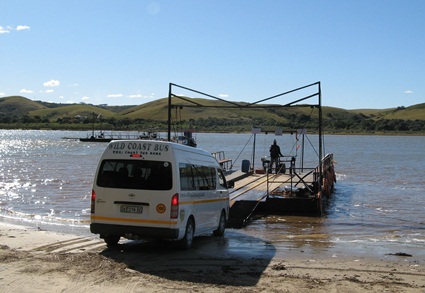
[Monday 27 June 2011 : Cape Town-Trennery's] "We're almost there" was the terse text message we received from Alan as we stood in the queue at Cape Town International airport, waiting to board our 1Time Airlines flight to East London.
Karen and I looked at each other. "Almost where?" I asked. "The airport? The check-in desk? The front door at home?" We looked around and could see no sign of Alan, Nicola, Caitlin and Sean, the other four members of our hiking group and who were also booked on the flight that was just about to take off. We shrugged. There was nothing we could do about it ; if they missed this plane there wouldn't be another one to East London until the next day.
Ten minutes later we were on the plane and seated, looking up the aisle as the last few passengers boarded. Still no sign of them. Then, just as we thought we'd be hiking by ourselves, I saw Alan stowing his daypack in an overhead compartment several rows ahead of us, a light film of perspiration on his brow. "I bet they were delayed at the Mugg & Bean" I said to Karen [Aside : Mugg & Bean is a chain of coffee shops in South Africa ; there is an outlet at Cape Town International airport].
The mishaps weren't over for the day yet, but the flight was on time, none of our bags went missing after we landed in East London and the bus that was due to transfer us to our first night's accommodation was waiting for us when we exited the airport. I'd last been to East London six years previously and the airport had clearly had a makeover since then - it's still small, but is bright and airy with gleaming tiles and now boasts a couple of decent restaurants, including a Mugg & Bean coffee shop. Alan pointed at it, confirming my suspicion as to why they'd been late for the plane. "That was the culprit in Cape Town" said Alan. "We were enjoying our coffee and lost track of time."
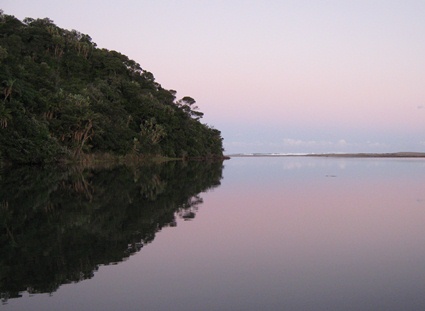
Kyle stopped us just as we were about to board the bus. "My wallet is missing" he said. "I bought a drink on the plane and now I can't find it." He was searching his pockets and backpack frantically. Not feeling very hopeful, I went with Kyle to the 1Time Airlines sales office in the airport and explained the situation to the lady behind the counter. To my absolute amazement she immediately opened a drawer and pulled out Kyle's wallet. "Is this it?" she asked. I couldn't believe it - the wallet had been found by somebody on the plane and handed in without a cent stolen from it, all before we were even aware it was missing! I thanked the lady profusely and asked her to extend our thanks to the staff member who had found the wallet - his or her honesty was a credit to the airline.
The airport wasn't the only thing around East London to have improved. Our bus headed north-east out of town on the N2 national road and before long we turned onto the side road to Kei Mouth. I'd been dreading this drive, because when Karen and I had come this way in 2001 (ten years previously) the road to Kei Mouth had been a kidney-rattling, bone-jarring track, 40 nerve-shattering kilometres of potholes, corrugations, stones and dust. But things had moved on since then and we sailed all the way to Kei Mouth on smooth tarmac. It was only when we took the road from town down to the river that we had to travel on a dirt-track, and that was for no more than 200 metres.
Kei Mouth is a small village at the mouth (on the west side) of the Kei River, the biggest river in the Eastern Cape. We were headed for Trennery's, a hotel on the east side of the river. There is one bridge across the river but it is many kilometres from the mouth ; if we'd gone that way it would have taken several hours to get to the hotel.
Luckily there is another way - a rough and ready pont across the river, a few hundred metres from the river mouth. The pont is no more than a flat metal platform with room enough for two vehicles and some foot passengers. Powered by a stinking and sputtering diesel engine, it has no fixed schedule but simply goes across the river whenever cars or people appear on either bank. There was another mini-bus wanting to cross the river just behind us, so we drove straight on board and were ferried across to the other side with the minimum of fuss.

Unfortunately the Kei River also marked the end of smooth tarmac, and when we drove off the pont we were back in the land of kidney-rattling gravel roads. But it wasn't far to Trennery's and almost before we knew it Karen and I were humping our bags into our cottage at the hotel. Lunch was a quickly-shovelled plate of spaghetti bolognaise and then we were off again, this time on foot and led by a local chap called Trevor down a path to the beach.
The Qolora river flows into the sea just north-east of the hotel, a meandering zig-zag which has resulted in a strip of sandy beach with the river on one side and the sea on the other. Trevor's colleague Carlos had a boat moored on the river near the path up to the hotel. We all climbed in and went puttering up the Qolora River ; the water was very calm and still, but a couple of weeks previously this placid river had flooded and been a ferocious, raging torrent that had uprooted trees and destroyed houses and boats - a good example of why this area is called the "Wild Coast".
We reached an impassable section of the river, whereupon we disembarked and walked along a grassy trail next to the water until we reached a weir. Carlos was there waiting for us with another boat, but much smaller - it needed three trips to ferry us all up the river and through a narrow ravine to a rocky ledge. The ravine was quite spectacular, with high rock walls on both sides of the river that converged overhead until there was only a narrow strip of daylight at the top.
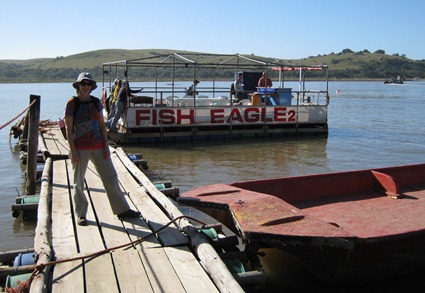
We climbed over the rock ledge and found a magnificent natural rock pool on the other side. "Anybody want to swim?" dared Trevor. "Most people don't - the water's too cold".
No way could I resist a challenge like that ... and before I had a chance to think about it and change my mind, I stripped off and jumped in ; holy mackerel, it wasn't cold, it was **** FREEZING. I dived under a couple of times then climbed out into what felt like blazingly hot sunshine (odd, I'd thought it was quite chilly a couple of minutes before). Alan also jumped in, followed by Kyle and Scott, cheeks and lips blue from the cold when they climbed out. After drying off we went back to the weir in the small boat then returned to the beach via a path on the other side of the river, over a high ridge that afforded spectacular views across the rolling Wild Coast hills.
[Tuesday 28 June : Trennery's-Morgan's Bay] The first day of our walk along the coast dawned bright, clear and sunny. As would become the routine, we packed our main bags and left them at the hotel reception (to be taken by car to our next overnight stop) and collected our packed lunches. Alex, our guide for the day, was waiting at reception for us and we followed him out of the hotel grounds, carrying only small day-packs. The first part of the walk was along the length of the local airfield - a long, flat section of grassy land that had been cleared of trees and bushes. There were no buildings of any kind and it was pretty bumpy and potholed, so even though I know next to nothing about planes and flying I would be pretty nervous about landing any kind of aircraft there.
Beyond the airfield we descended through a rustic picnic area, skirted a river whose mouth was closed and found ourselves on the beach. This was the start of many hours of walking over the next four days along seemingly endless stretches of beach, most of them deserted bar the occasional lonely fisherman. The beach was seldom straight, but instead comprised multiple bays with rocky headlands separating them.
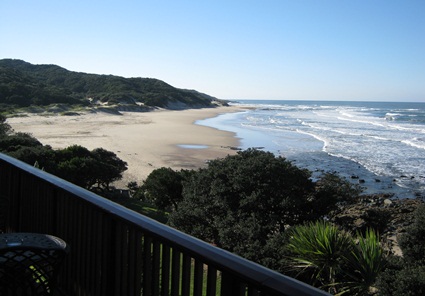
With the Wild Coast surf pounding the shore on our left we ambled south-westward, our party breaking up into smaller groups and re-forming as people stopped to explore rock pools or look for shells. We passed a number of rivers with closed mouths before rounding a sizeable outcrop of rocks, beyond which we could see the blue waters of the Kei River. The Kei is far too wide and dangerous a river to attempt to swim across - the plan was for us to go over on the pont (the same pont we'd driven over the day before).
The terrain for about half a kilometre next to the river looked very much like it had been flooded recently ; the sand had that telltale "packed smooth" look that you see when it has been under water. And near the river we saw an incongruous sight - an old rusty metal pont on the beach, buried deep in the sand and being washed over by waves. None of us could throw any light on it so we trudged on, carefully threading our way through groups of the cows that are an ever-present feature of the Wild Coast.
When we reached the river our guide left us and headed back the way we'd come. We climbed onto the pont and were ferried across again, and on the other side were directed to a boat moored nearby. This was the Fish Eagle 2, a craft used for leisure trips up the river. Once we were all on board the skipper introduced himself as Louis, told us to help ourselves to the finger lunch on the table (sandwiches, pastries and sausages) and cast off. We slowly chugged up the river, enjoying the sunshine and the magnificent views of the rugged Eastern Cape. Louis explained that in the floods two weeks before the river had ripped the old pont from its mooring and hurled it out to sea ; several days later it had been washed up on the beach and buried in the sand where we'd seen it. It was hard to believe that the mild and placid river on which we were cruising could have been transformed into such a vicious torrent, but such is the overwhelming power of nature.

Once we were far enough up-river Louis started pointing out fish eagles perched on trees and rocks on both sides of the river. He had a supply of pilchards in a cooler box and periodically threw one overboard ; it was amazing to watch the fish eagles swoop down from their lofty vantage points and snatch the fish from the water with their claws, barely pausing or causing a ripple on the water.
On the way back, while we were all struggling to stay awake in the sun, Louis explained that his boat was previously used for dinner and booze cruises. But he was forced to stop because people always got drunk (which wasn't really a problem) and then frequently fell overboard (which was a problem, and a major one).
Back at the river mouth we bade farewell to Louis and the Fish Eagle 2 and continued our walk. We skirted the high cliffs on the west bank of the river, past the tiny holiday settlement of Kei Mouth and onto a dirt road that paralleled the sea for a short distance. The road became a track that wound round the perimeter fence of a lighthouse and down to an old stone building perched on some rocks above the sea. We looked around for a while, and I realized that this building, now completely derelict and ruined, was called The Pumphouse and was until recently used as the first overnight stop on the popular Strandloper Hiking Trail from Kei Mouth to Gonubie (which Karen I and I had walked in 2001 ; we had slept in it on rough wooden bunks). The Pumphouse was originally just that - it was used to house machinery that pumped sea water up to a titanium mine that operated in the dunes from 1953 to the 1990's. Environmental protests eventually forced the mine to close.
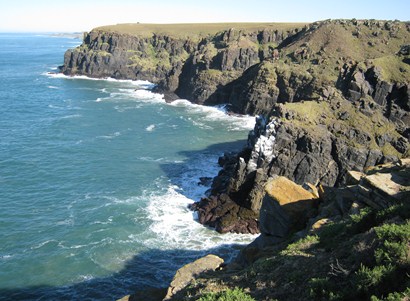
The Pumphouse had been fairly rough-and-ready when Karen and I had been there in 2001, but now it was completely ruined - some of the walls and part of the floor had collapsed. It looked like a massive storm had wreaked havoc, and later that day the manager at Haga Haga confirmed that this is indeed what had happened. Shortly after leaving the Pumphouse we hit a long, straight beach for the final leg of the first day's walk to Morgan's Bay. The sun was low in the west as we checked into the Morgan's Bay Hotel, a family-oriented establishment that is superbly sited on a magnificent sweep of beach. Our room had a balcony overlooking the sea and we relaxed and enjoyed the view, but I had an urge to swim so I headed back down to the beach again.
By this time the sun was down and it was chilly on the beach, so I ran hard for as long as I could to warm up then plunged into the water. It was incredibly warm, and I enjoyed a long thrash in the pounding Wild Coast surf before the lure of supper forced me out. I ran hard back to the hotel and slopped dripping and sweating up to our room. Karen hadn't budged and was still sipping tea on the balcony. She regarded me with a look that said "Are you mad?" and was entirely unmoved when I described how warm the sea water was.
Supper that night in the Morgan's Bay Hotel was a magnificent affair - five courses of absolutely delicious food, with the piece de resistance being leg of lamb roasted to perfection. The only down side was the weak coffee, a problem which was to haunt us at every place we stayed over the next few days. I guess people in the Eastern Cape like their coffee weak, but for Karen and me, used to having our morning caffeine jolt black and strong (Italian-style), it was a major disappointment.
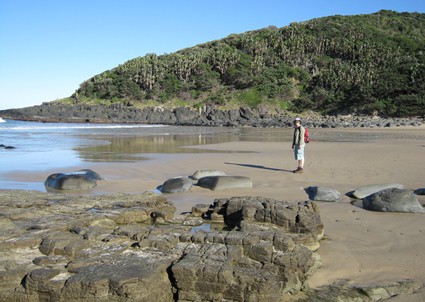
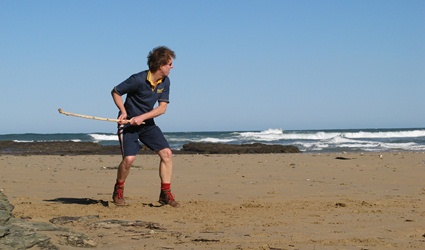
[Wednesday 29 June : Morgan's Bay-Haga Haga] We managed to struggle through a massive breakfast at the Morgan's Bay Hotel before collecting our lunch packs and heading off down the dirt track between the village and the sea. Just out of town we had to toil up quite a steep hill, which led us to an expansive grassy cliff top. The waves pounded the rocks far below us as the path wound round and along the top of the jagged cliffs. Then there was a tricky descent into a narrow kloof (aided by some chains bolted into the rock face) and onto a rocky shore. For the next few kilometres we negotiated a series of wave-cut platforms, extensive rock formations shaped into weird patterns by the relentless pounding of the sea.
Midday found us at a broad river mouth, blocked and dry as most of them seemed to be. The river had formed a lake behind the silted-up mouth, a wide expanse of shimmering blue water. We ate our packed lunches in the shade of rocks on the side. Alan pulled a tennis ball from his pack and suggested a game of cricket on the hard-packed sand, so we found a "bat" (a stick) and took turns batting. Very enjoyable, but we kept having to move the pitch as the batsmen's feet scuffed up the sand.
After lunch we came to Double Mouth, a river mouth that is unusual because two completely separate rivers converge and run into the sea at the same point. It is a fabulous spot in summer with a grassy camp site nearby, but at this time of year there were only a few hardy campers there.
Just beyond Double Mouth we crossed a very fast-flowing stream of strangely-coloured water. It was extremely odd, because every river mouth we'd seen since the Kei had been dry (and many of them had been major watercourses) yet here was one that was only a couple of metres wide and yet it was flowing strongly. In addition the water was a very sick green colour and somebody had built a wooden bridge over it (for which we were very grateful, because none of us had any inclination to touch that grungy water). We looked around carefully and noticed well-maintained barbed wire fences and long low buildings upstream from the river, almost hidden by the dunes and bushes, and realized that it was the Perlemoen farm we'd read about. The Chinese owners of the farm are clearly obsessed with security (and perhaps they should be - Perlemoen is an expensive delicacy in these parts). The water in the stream was obviously being pumped out from the farm, which made me wonder how it was replenished ; I gazed back down the beach and saw that what I'd thought was a hump of sand was actually a pipe used for pumping water up to the farm.
Late in the afternoon we saw the little village of Haga Haga in the distance. We straggled into the hotel and checked into our rooms, all four of which were on the ground floor and facing the sea. Unlike the hotel in Morgan's Bay (which had been boisterous and noisy), the place was deathly quiet ; the manager explained that they had had a very tough season and we were the only guests in the entire hotel that night. The decor and style of the place was very much from the 1970's and was a little faded around the edges, but the staff were extremely pleasant and welcoming - in fact, they had baked a cake especially for us! So we simply dumped our backpacks and sat in the lounge, sipping tea and quaffing lemon meringue pie. Because the hotel was so empty we didn't eat supper that night in the main dining room but in the pub, where the fare was adequate but fairly basic.
[Thursday 30 June : Haga Haga-Crawford's] Even though we were the only guests in the Haga Haga hotel, the kitchen staff still laid on a magnificent (and massive) breakfast for us. I bravely fought the desire to pile my plate high with bacon, eggs, mushrooms and sausages but failed dismally, so once again I found my stomach uncomfortably full as we headed onto the beach for our third day of hiking. For the first couple of hours it was quite slow going as we clambered over seemingly endless rocks, and it was with a feeling of relief that we rounded a headland and stepped onto a beach again. However, the enjoyment only lasted a few seconds because the wind on the beach was a ferocious, howling gale that was blowing directly into our faces. Every step was a struggle against the wind and the sand that was being swept along the beach, scouring our legs and filling every pore and crevasse.
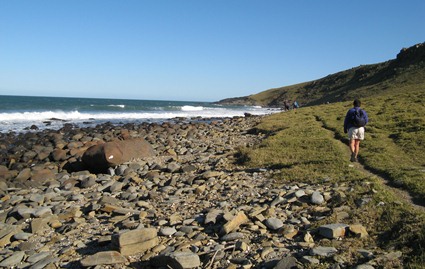
Conversation was impossible. Our group quickly became split up as each person put their head down and walked at their own speed. After a couple of hours I joined Alan and Caitlin in the minimal shelter of a small dune and waited for the others to catch up ; we sat there and ate a fairly miserable lunch, spitting sand out of our mouths as the wind howled around us. Then it was back into the wind again for the last leg of our trip, another couple of hours of slogging before the welcome relief of the Crawford's sign came into view.
From the beach we climbed up some steep steps to the luxurious resort of Crawford's Lodge, a series of thatched wooden cabins in the forest clustered around a swimming pool and a central building containing a dining room and lounge. We dumped our packs, collapsed into comfy chairs and enjoyed coffee and cake while our rooms were being prepared. On the big screen TV Victoria Azarenka and Petra Kvitova (the eventual winner of the tournament) were slugging it out in one ladies' semi-final of the 2011 Wimbledon Tennis Championships. Perhaps I should say "grunting it out", because these two ladies are fine examples of the modern trend amongst female tennis players to exhale loudly during and after every stroke - a trend started by Monica Seles some years back [Aside : Monica Seles and Steffi Graf were the two dominant women tennis players of the early 1990's until a disturbed and enraged fan attacked Seles with a knife and injured her so badly that she was out of the game for over two years. When she returned she was never quite able to recapture her previous form, but did succeed in winning one last major title - the 1996 Australian Open. Graf went on to win 22 Grand Slam titles, just two short of the record of 24 held by Australian legend Margaret Court].
Crawford's gave our group two adjacent cabins, both double-storey, with an en-suite double bedroom upstairs and another bedroom with two single beds downstairs. The furnishings were exquisite and we revelled in the luxury after the hardest day of walking we'd had so far. By this time it was quite late but I was determined to have a swim before supper so I headed back down to the (completely deserted) beach and plunged into the sea. It was pretty cold, nothing like it had been at Morgan's Bay a couple of days ago and before long I was sprinting back up the wooden stairs to the lodge. The swimming pool caught my eye as I was walking past, and seeing as I was already wet and cold I thought "What the hell" and dived in ... and quickly discovered that the sea water I'd been in a few minutes before had actually been quite warm.
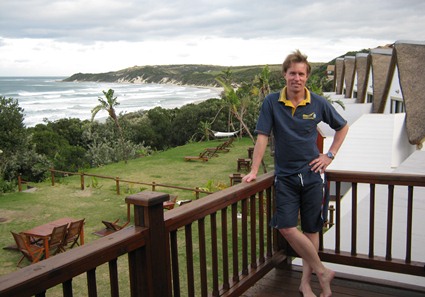
Two nights before we'd thought that dinner at Morgan's Bay Hotel was good, but we were blown away by the magnificent repast we enjoyed at Crawford's that evening. It was a buffet, and each dish was a taste sensation. Dessert was a similarly-delicious array of mouth-watering (and waist-thickening) concoctions, and after working our way through that spread Karen and I just about managed to stagger back to our cabin where we crept into our soft bed and slept like the dead.
[Friday 1 July : Crawford's-Inkwenkwezi] We checked out of Crawford's Lodge and were collected in an open land-rover by a jovial ranger called Roger from Inkwenkwezi Game Reserve, a private operation in the hills behind the town of Cintsa - at this point we'd finished the "walking" part of our trip and could now look forward to two days of relaxation in a game reserve. It was only a twenty minute drive from Crawford's to Inkwenkwezi but it was mid-winter and the wind was raw and icy in the back of the open land-rover. Thankfully it was much warmer inside the reserve as Roger drove a twisting route on rough 4WD tracks before dropping us off at four widely-separated tented cabins in a wooded valley. Each set of parents and each set of children had their own cabin and each cabin was completely out of sight and earshot of any of the others ; you could walk the short distance between them on gravel paths through the trees.
Each cabin was part canvas tent and part wood, with a bedroom, tiled bathroom and a broad deck looking across the valley. I found some wine in the fridge so I opened a bottle and Karen and I sat on the deck in the sunshine, enjoying the view and the stillness of nature. And then it was time for lunch, which again proved to be a gastronomic feast of note. We ate in a semi-enclosed stone building overlooking a deep valley, before we all piled into Roger's land-rover for a game drive. He drove round the park and we saw a variety of game but no predators ; Inkwenkwezi does have lions but they are kept in a separate enclosure, and their leopards are (as always) elusive and incredibly difficult to spot.
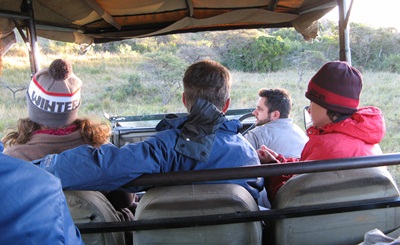
We ended the drive at the lion enclosure. Unfortunately we couldn't go in, because a number of lions were clustered around the double gate and alongside the fence - it was simply impossible to open the gate without the lions getting out. So we stood outside the gate and watched them while they watched us. They showed no signs of moving so Roger abandoned the plan for the day and drove us back. By this time the sun was setting and it was very cold, even more so on the icy tiles of the draughty bathroom in our tent. A quick hot shower and we were ready for supper.
The usual procedure at these exclusive game reserves is that the ranger assigned to your group is at your beck and call 24 hours a day. Part of Roger's job was therefore to drive us backwards and forwards between our tents and the stone lodge where we ate our meals, a distance of no more than 100 metres - heaven forbid that paying guests should actually WALK. However, Karen and I don't like being babied so when we were ready for supper we just strolled up the road to the lodge ; it was easy to find even though it was getting dark. I think Roger was a little taken aback at his guests actually doing something for themselves but he seemed happy enough - it was less work for him anyway. From then on we walked to the lodge for all our meals.
[Saturday 2 July : Inkwenkwezi] Our first night in our glamorous-looking tent at Inkwenkwezi was freezing cold and we shivered most of the night. I turned the place upside down but could not find any extra blankets. Karen and I warmed ourselves with coffee on the deck in the grey light of dawn before heading up to the lodge for breakfast, where I asked Roger to organize a few more blankets for us that night.
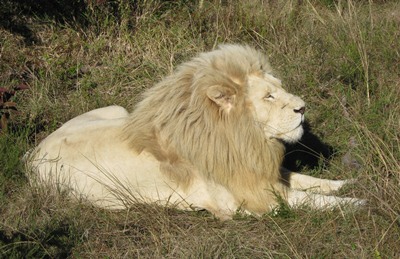
Then it was off again in Roger's land-rover. First stop was the lion enclosure, and this time we managed to get inside via the double gate because the lions were nowhere to be seen. Roger bounced around on rough roads and through bushes until we came across the lions lying around in the sun as cats do. The pride consists of one big dominant male, two young males (brothers) and many females, one of which is pregnant. It was a bit unnerving sitting in an open-top vehicle a couple of metres away from several prime examples of the most powerful predator in Africa, but they just stared at us with their unblinking yellow eyes and left us alone. For me, the problem was that the Inkwenkwezi lions are kept isolated in a small enclosure and fed dead goats and cows - they aren't wild, cannot roam free and do not hunt for their own food. When I asked Roger about this he said they had tried releasing live antelope into the lion enclosure, but because the space is so small and confined it was simply cruel. "Buck don't last ten minutes in here" said Roger. "They have nowhere to run so the lions just corner them and kill them. We couldn't keep doing that".
Roger also said that there are long-term plans to release the lions into the main reserve, but I can't see that happening for several reasons - the cost of lion-proofing the main fence, each guest tent and all the lodges would be prohibitive and (most importantly) the lions would not be available on demand as they are now in their small enclosure. Finding wild lions in a significantly-sized reserve is a difficult job, whereas in a confined space you can simply drive around and be guaranteed to find them in ten minutes, thus keeping your well-heeled and impatient guests happy. Never mind the fact that the lions would also start eating the rest of the game in the reserve ; much cheaper to feed them a goat from a butchery than have them kill an expensive wildebeest ...
Roger then drove us back to the main lodge (not the small one where we ate our meals), behind which is a cheetah enclosure and an area for Inkwenkwezi's three juvenile elephants. These elephants are semi-tame and live in a separate section of the reserve with three human handlers and (oddly) a dog. The elephants are still quite young and aren't fully grown yet - a male aged 13 and two females 10 years old. This is a most unusual grouping for elephants, which are sociable creatures and normally live in large herds led by a relatively old female (the matriarch).
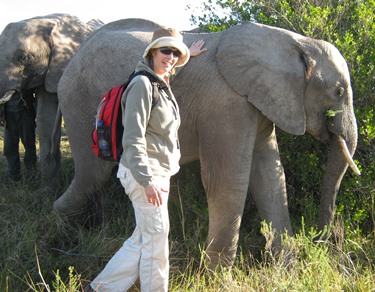
Karen interacting with the elephants at Inkwenkwezi
To have only three elephants in a herd with the oldest being as young as 13 (and a male not a female) means that they had no natural leader and no older, more experienced individuals to teach them the ropes - a very stressful and uncertain situation. The dog was therefore introduced to the elephants and lives with them permanently. He usually runs ahead and keeps them appraised of danger, a ploy which has been very successful and keeps the elephants calm and not as skittish as they were.
The handlers brought the elephants slowly to us and we took it in turns to touch them and feed them some tasty morsels. But while interesting, the whole experience had a "canned wildlife" feel about it.
Nearby is a tiny fenced area where three tame cheetahs are kept - a male and two females. We went inside and touched and patted the cheetahs, who walked around us and purred just like domestic cats. I always thought cheetahs don't climb trees, but one of them was way up a tree when we arrived and ran down as easily as any cat would, so I don't think much of that theory any more. They are quite tall but very slender and agile. And when they move, they are so quick it is scary.
During lunch there was quite a lot of discussion about what to do in the afternoon. Alan and the children were very keen to go quad-biking, but Karen, Nicola and I elected rather to visit the elephants again and walk with them though the bush. My view was that you could ride a quad-bike anytime, but walking with elephants wasn't something that was likely to crop up again in a hurry, so to me it was a pretty simple choice ... Stuffed to the gills with excellent food again, we went our separate ways - Roger with the three boys, Caitlin and Alan to rip up the environment and make a lot of noise on quad-bikes while another ranger took the two ladies and me to a separate section of the reserve where the elephants lived. The handlers were waiting for us and introduced themselves and the three elephants to us. Then we walked slowly through the veldt, the dog ranging ahead and Nicola, Karen and I gingerly patting the elephants and taking photos. The elephants were clearly very accustomed to this because they largely took no notice of us. After half an hour we came to an area where the ranger had parked the land-rover, so we bid farewell to the lumbering pachyderms and their handlers and bounced back to the main reserve.
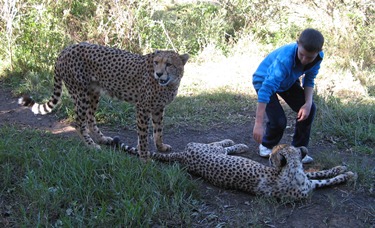
The ranger driving us had obviously been in contact with Roger, because we drove back through the reserve a different way and came across Roger's land-rover parked next to the road. And then we saw why - no more then ten metres away were two white rhinos, the rarest of sightings. Unlike black rhinos, white rhinos are pretty placid so we were able to get out of the vehicles and take some good photographs. Fantastic! I had only ever seen one rhino before, a fleeting glimpse in the Kruger National Park many years before, so to see two of them so close up was a real treat. I just hope Inkwenkwezi's rhinos don't go the way of many other rhinos in South Africa - ruthlessly slaughtered for their horns.
Supper that evening was a boisterous affair. The South African national endurance off-road motorcycling championships had taken place that day on some land nearby and most of the riders were staying at Inkwenkwezi that night ; they all had supper in our lodge and partied until the early hours.
[Sunday 3 July 2011 : Inkwenkwezi-Cape Town] Our last day at Inkwenkwezi. We had a leisurely breakfast at 9 AM, packed our stuff and waited at reception for the bus to take us back to East London airport. After all the eating we'd done I could not face another morsel, but this did not deter some of the others from ordering more food at the Mugg & Bean in the airport, where we reflected on a fantastic holiday before boarding our 1Time Airlines flight to Cape Town.